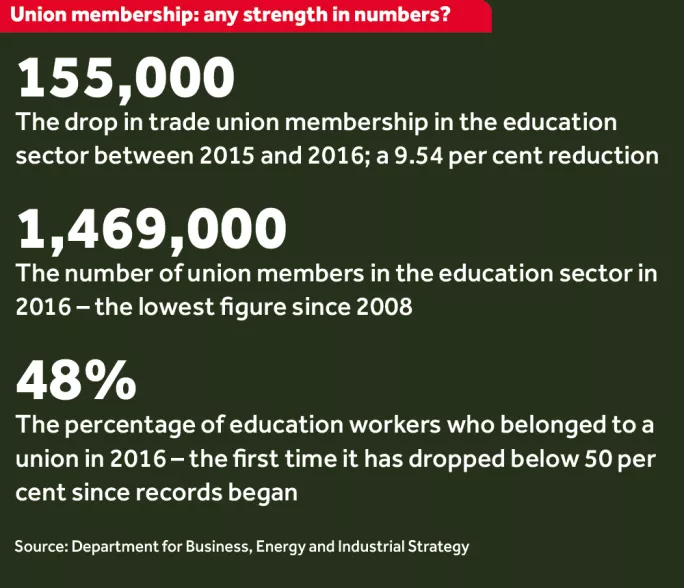Decimation of the education unions: no cause for alarm?

On the face of it, new statistics showing a huge fall in union membership in the UK education sector look worrying for teaching unions.
According to the Department for Business, Energy and Industrial Strategy figures published last week, union membership in education dropped from 1,624,000 in 2015 to 1,469,000 in 2016 - representing a whopping 9.54 per cent fall in a year.
The figures cover further and higher education as well schools, and also include support staff. But with teachers comprising the lion’s share of the education workforce, should their unions be alarmed?
Daniel Tomlinson, a researcher at the Resolution Trust, suggests the drop could be the result of the demographic pressure affecting the rest of the trade union movement - the retirement of the baby-boomer generation.
“They came of age and began to become active in the labour market in the 1970s, when trade union membership was at its record,” he says. “Now you have younger workers joining the labour market who are just much less likely to become members.”

The proportion of trade union members over 50 was about 22.5 per cent in 1995; by 2016 it stood at roughly 39 per cent. However, Mary Bousted, general secretary of the ATL teaching union, says teaching remains a profession where high numbers of new entrants continue to join a union as a matter of course.
“We don’t have evidence that our younger membership is dropping,” she says.
Even if appetite for union membership among new teachers has declined, it seems likely that something else is at work to account for such a sudden and large year-on-year drop.
Of the 275,000 fall in overall UK union membership numbers between the last quarter of 2015 and the last quarter of 2016 (the biggest annual decline recorded since 1995), education made up more than half. The previous year, education membership actually went up.
Teachers quitting the profession
Union leaders point the finger at people leaving the sector - both voluntarily and because of redundancies.
Bousted says her membership is down by about 1 per cent, and that a crisis in teacher retention is a factor.
“The fact that less than half of teachers now have more than 10 years’ experience in the classroom means just like schools, unions have to work harder just to catch up,” she says. “It’s not that we’re less successful at getting people to join, it’s that they leave far more quickly.”
Jon Richards, Unison’s head of education, blames cuts to jobs due to funding pressures. “We’re recruiting at similar levels as we always have done,” he says. “What’s happening is we’re having increased number of leavers, and that’s partly due to redundancies that we’re seeing across the whole of the sector.”
Richards says Unison has lost a “few thousand” education members over the last couple of years, but the decline is “nowhere near” 9.54 per cent.
Office for National Statistics figures seem to back up the argument that a contraction in education jobs has hit union membership.
They reveal a 90,952 - or 9 per cent - drop in the number of people employed in UK secondary education across the period in which the trade union figures were collected.
Kevin Courtney, general secretary of the NUT teaching union, agrees with Richards that “attacks on the public sector...have led to the loss of many jobs”.
However, NUT membership grew in 2016 and the NASUWT, the second largest teaching union, also claims to have had “steady year-on-year growth”.
But the government’s trade union membership figures come from an ONS labour force survey of a sample of about 100,000 people. So Tomlinson says they could differ from the unions’ own membership figures.
He warns against over-extrapolation from the statistics: “I wouldn’t say this definitely shows that there’s a big start of a trend of falling membership in the education sector - we might see that it rebounds again next year”.
The proportion of education employees who belong to a union appears to have decreased. But, at 48 per cent, the sector remains the most unionised part of the economy.
You need a Tes subscription to read this article
Subscribe now to read this article and get other subscriber-only content:
- Unlimited access to all Tes magazine content
- Exclusive subscriber-only stories
- Award-winning email newsletters
Already a subscriber? Log in
You need a subscription to read this article
Subscribe now to read this article and get other subscriber-only content, including:
- Unlimited access to all Tes magazine content
- Exclusive subscriber-only stories
- Award-winning email newsletters